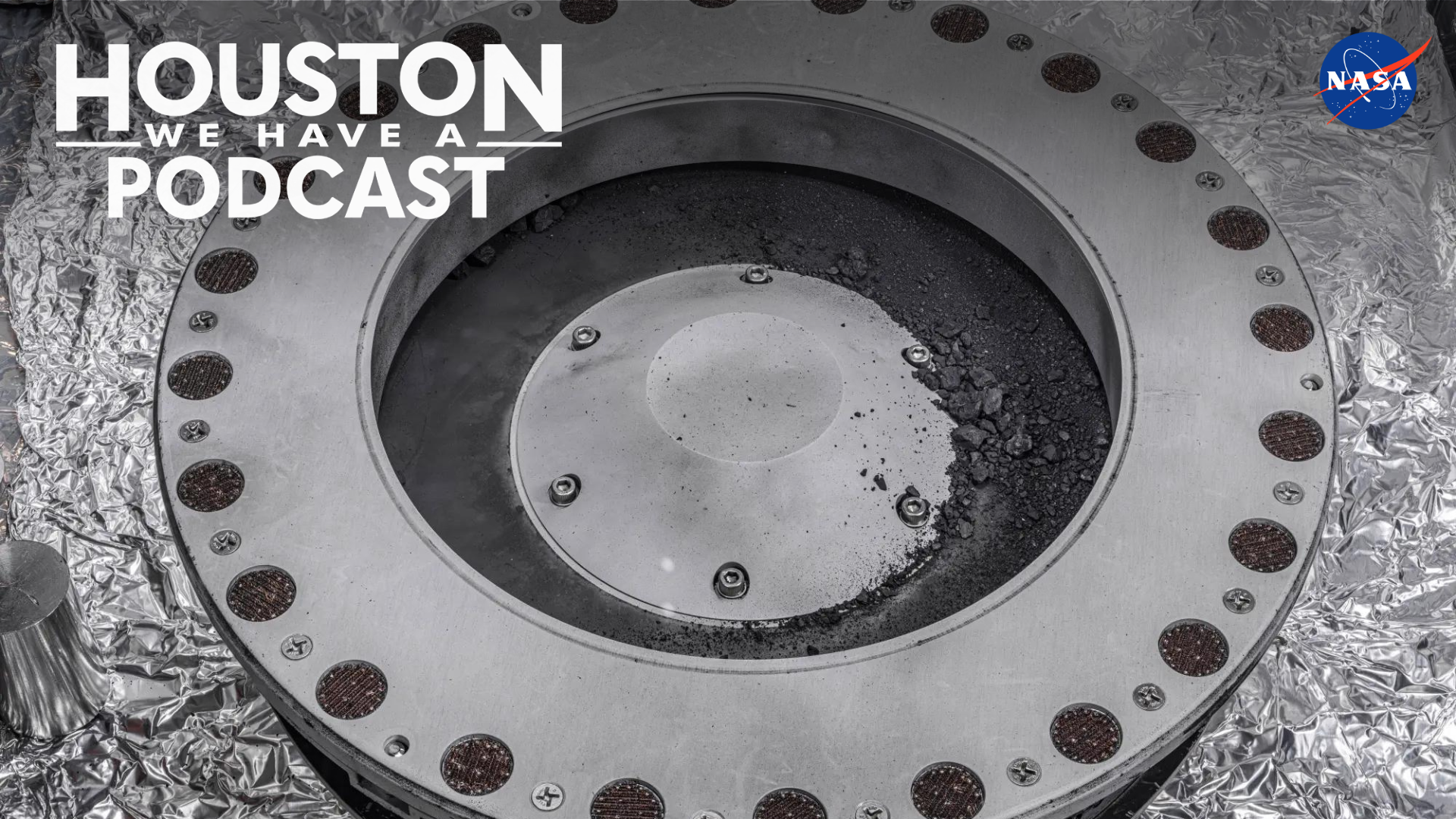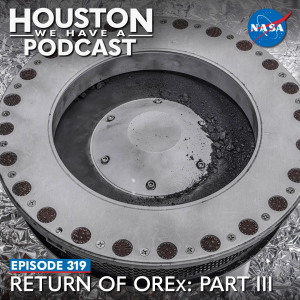
From Earth orbit to the Moon and Mars, explore the world of human spaceflight with NASA each week on the official podcast of the Johnson Space Center in Houston, Texas. Listen to in-depth conversations with the astronauts, scientists and engineers who make it possible.
On episode 319, planetary scientists and OSIRIS-REx co-investigators at NASA’s Johnson Space Center walk us through the processes and emotions of working in the lab with asteroid Bennu’s precious samples. This episode was recorded on November 7, 2023.

Transcript
Host (Gary Jordan): Houston, we have a podcast! Welcome to the official podcast of the NASA Johnson Space Center, Episode 319, “Return of OREx: Part III.” I’m Gary Jordan, I’ll be your host today. On this podcast, we bring in the experts, scientists, engineers, and astronauts, all to let you know what’s going on in the world of human spaceflight and more. OSIRIS-REx, or Origins, Spectral Interpretation, Resource Identification, and Security-Regolith Explorer has returned back to Earth. The spacecraft launched in 2016 to rendezvous with an asteroid called Bennu in 2018, so it can retrieve pieces of the asteroid with it on a trip and return them to our own home planet for study. After a successful landing in the Utah Desert on September 24 this year, 2023, the sample was transported here to Houston, where we have specially designed facilities to keep them pristine. On October 11, NASA revealed a first look of the sample, as well as some early discoveries to the world. Now, we’ve previewed this mission twice this year already for setting the stage for its return and discussing Bennu and the interesting science with Mike Morrow and Nicole Luning. Then we brought in Christopher Snead and Mari Montoya to discuss the curation facility where the samples are currently housed, diving deeper into the prep here in Houston.
On this episode, we round out the story of these samples with more of the scientists here in Houston who have been working with these unique samples. We’re bringing in planetary scientists and OSIRIS-REx co-investigators, Lindsay Keller and Ann Nguyen from the Astromterials Research and Exploration Science Division here at NASA’s Johnson Space Center, to walk us through the processes and emotions of working in the lab with these precious samples. Quick note that we had some activity happening in our studio, so you might hear some background noise in this episode, but trust me, I did not want to interrupt these folks. They had some amazing stuff to share. So let’s get right into it. Enjoy.
[Music]
Host: Lindsay and Ann, thank you so much for coming on Houston We Have a Podcast, so happy to have you.
Lindsay Keller: Happy to be here.
Ann Nguyen: Wonderful to be here.
Host: Can’t tell you how much I’ve been itching to have you both on the podcast. We’ve had a couple of discussions on OSIRIS-REx not only this year, but over the years. And the sample reveal event that we had in October of this year was absolutely amazing. I’m still coasting off of the energy of that whole thing. I’m sure you guys got to be a part of that as well. Lindsay, what was your experience for the reveal event?
Lindsay Keller: It was fun. I mean, you know, again, it’s the fruition of a lot of work and effort and, you know, being able to go out and show the rest of the world, have my family tune in and everything else, to the press release was fabulous.
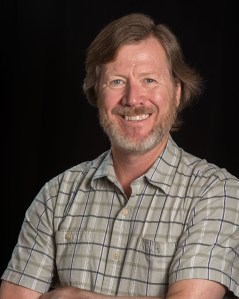
Host: Ann, same thing.
Ann Nguyen: Absolutely. It was just amazing to think that what you’re seeing on the screen here is being broadcast to the next generation, you know? Not only to scientists, but they had school ages there asking questions. That was awesome to see. And then just thinking that, you know, these samples that we’re seeing here were on Bennu out in space, you know, not too long ago. Well, kind of not too long ago. Couple of years.
Host: Yeah. But still, I can understand that. And what’s interesting is, and I can’t wait to get to this later in this episode, you got to experience working with these samples, seeing the samples, doing the science of these samples that we revealed to the world as part of the October event. You got to do so ahead of time and have maybe more intimate moments than this grand event that was very public, and I can’t wait to get to it. But first of all, I just want to mention that both of you are so well accomplished people. Planetary scientists, and OSIRIS-Rex co-investigators. You have wonderful accolades, and I want to get a sense of what led you to this particular role and working on these pristine samples. Lindsay, why don’t we start with you? What led you down the path of wanting to pursue, wanting to become a planetary scientist and your entrance into working as part of the OSIRIS-REx team?
Lindsay Keller: Just a fascination with space, with rocks from space. I’m a mineralogist. I’m a geologist and study things at the atomic scale. These are just wonderful samples to work on. They’re exciting. They’re different from terrestrial rocks in many ways. I started in graduate school, during my PhD, working on meteorites and things, using electron microscopes to do study there, tear them apart at that sort of scale. And I’ve moved on ever since. I arrived here in 2000 as a NASA civil servant. And then I was working on the Stardust mission, the mission that flew through a tale of a comet and collected the samples. I was a co-investigator on that mission as well. And I was brought in late in that, because missions at NASA take so long from when they’re conceived until they fly, that they needed to add a younger generation of scientists to work on that mission. So you know, I was very fortunate to get added to that mission as part of the science team. Because of that experience, almost 16 years ago now, the PI of OSIRIS-REx Michael Drake at the time, he was a professor at the University of Arizona, was looking to add science members to his team for his proposal effort. And based on our experience that we had done with Stardust, we had impressed enough people, and we got asked to invited to be on that team as well. So that went back to the first discovery proposal that was submitted for OSIRIS-REx that didn’t get selected, but the next two years later submitted the New Frontiers proposal that went through its process and got selected. So, yeah, I’ve been on this mission since 2006, basically.
Host: Wow. So, having that history with this must have been extra special when you finally got those samples. Cause you were there at its inception.
Lindsay Keller: Yeah. I mean, it’s like watching, I think I was telling a friend, it’s like watching your child grow up. You know, you see it from the conception all the way through to the end, which is what I missed with Stardust. You know, Stardust, I came in at the tail end, samples were coming back in six months and away we ran with it, you know? And so watching this all the way through the process is just incredible. You realize what a ginormous team effort this is in terms of the thousands of people that make this happen. We’re sitting here right now, so excited about getting our samples and everything else, right? You have this 16-year effort, you know, to design the spacecraft, design the flight characteristics, design the sampling device, fly it, land it, bring it back, and here finally, now we get to have all the fun. But there’s all this legion of people that had to work so hard, and they’re so smart. And so it’s just an amazing, amazing effort.
Host: It’s good to recognize that. I think as part of the reveal event that we did in October, we did a pretty good job of just bringing in all the different players. Even then I feel like it was very apparent that even though there were a lot of people present, a lot of people who worked on this, that it was still much wider, much broader sweep than even we could possibly represent. It truly does take a team. It’s great to be talking with you, Lindsay, after working on it for so long. Ann, I wonder what your experience is, planetary science. What got you interested in planetary science and then eventually, as part of the OSIRIS-REx team?
Ann Nguyen: Yeah. So I actually, as a kid, wanted to be an astronaut. And I was always interested in space. I didn’t become an astronaut, but, you know, missions like these allow me to kind of be that space explorer that I always wanted to be. So actually in college, I studied chemistry. I was going to be a pharmacist, but that didn’t really quite pique my interest. I was like, you know, astronaut, pharmacist. And then I started taking astronomy and astrophysics courses and wanted to find a path that could combine those two fields. And then I found the field of cosmo chemistry, and particularly studying my first work with meteorites involved looking at chondrules, which are the first formed, or one of the first formed, solids in the solar system. Then I found a graduate program at Washington University where they call it the fourth floor in physics. And they kind of pioneered the field of studying presolar grains, which are grains that condensed around stars beyond our solar system, way beyond our solar system. And they died, you know, billions of years ago. And these tiny grains kind of floated in space and got encapsulated into our molecular cloud. And they’re found in primitive astroidal materials and cometary materials. And so that’s how I kind of got involved with studying these hand samples and interested in studying meteorites.
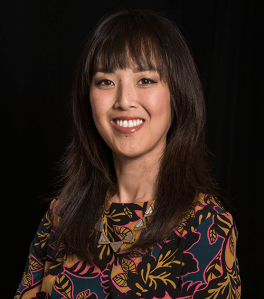
So I’ve been at NASA since 2008, but I came on as a civil servant in 2020. So my involvement in the mission came a little or later than Lindsay. Formally came on board in 2019. So I was kind of on the tail end of that. But, you know, they brought me on for kind of my expertise in studying presolar grains and primitive organics and early solar system materials. So our team is made up of 200 plus scientists. It’s great to see everyone has a different background and interest, and their particular thing, they want to study. I’m really interested in presold grains. Others are interested in calcites or altered materials. But having all of us come together and putting those pieces together really makes it fun.
Host: So, yeah, there’s a lot of different angles, and I think that’s a theme that we can get to when we start really diving into the samples. It’s not just space rocks. There are a lot of different, very interesting angles that you can take, scientific angles that you can take, to investigating these. And I say this a lot when we talk about astromaterials on the podcast, is rocks are stories. I’m sure you guys talk about that a lot. I think that’s one of the most fascinating things about the area that you guys are in. It’s not just rocks. You are looking at the story of the solar system, the story of formation, the story of the universe. It’s quite fascinating.
Lindsay Keller: Well, I mean, if you look at the sample analysis plan that the mission has presented, it is characterizing the rocks and such, but we have a series of themes, sort of fundamental science questions that we’re trying to address. Starting from the building blocks of the solar system that formed around other stars in the molecular cloud, how those come together to form an object. You know, how did those then become altered to what we see today? Bennu is a rubble pile. It was disintegrated in impact. We have 10 or 12 sort of working hypotheses that we’re testing with the entire sample analysis plan. So it is very oriented to solving sort of big picture questions about our origins and other origins.
Host: Fantastic. Going back to your story for just a second, Ann, I thought your arc of how you got to be a part of this mission was particularly fascinating. You wanted to be an astronaut and try different ways and different paths. And it was an interesting one. But I think there are a couple key elements here. Your interest in space, your interest in being an astronaut and your interest in space, cause naturally, even though you considered pharmaceuticals, you ended up going the space route. But I wonder why chemistry. Chemistry can be very challenging. And whether it was the chemistry of pharmaceuticals or the chemistry of the makeup of different elements of the solar system of in space, that was something that you were interested in. And I wonder why.
Ann Nguyen: Yeah. So, you know, I was going to pursue pharmacy. I got a job with a pharmacist as an assistant. And I just knew that wasn’t for me. I really wanted to do research. I think in college is where I learned that I really like research. And so I thought well then pharmacology, you know, researching drugs and pharmaceuticals, and that’s why I started into chemistry. But that took me down another path. It was really when I took that astronomy class, you know, astronomy 101, and that just sparked that love from my childhood. I was like this is me. This is where I need to be. And then you know, taking astrophysics and just combining all those things, I kind of found my home there.
Host: Yeah. Getting my degree, which is a business, you have to take a natural science elective, a certain set of them. And it can be anything. A lot of the business folks took energy, oil, and gas sorts of electives. I had to take three courses. And every single one, I took astronomy. I took Astronomy 101. I’m like” Eh, let’s see where this goes. And then maybe I can take the energy one.” But it was the same exact experience. I got locked in. I was like, “This is fascinating.” And so I took black holes, I took astrobiology, I took a bunch of follow-up courses that were just, I mean, it just locks you in.
Ann Nguyen: Yeah, and the other thing is, you know when I took astrophysics, I thought maybe modeling of evolution of stars, but then modeling wasn’t for me either. So it just came back to research. I love the chemistry labs. That was my favorite thing to do.
Host: Cool.
Lindsay Keller: No, I kind of resonate with your story, because I started as an architecture major. I had to take a science elective and I couldn’t get into a computer science class, so I took a geology class, just as a floating natural science class. Six months later I changed my major. And the rest is history, you know, and apparently, it’s a high statistic of number of freshmen that do exactly that, don’t really know. I mean, 70% of freshmen come in not really knowing what they want to do. And it’s like 70% change majors in like that first year.
Host: It’s a good program then if it’s so intriguing. Very fascinating. Now we’re going to get into OSIRIS-REx, I want to lead to the sample reveal. This is part three. We’re doing a little miniseries of the story of OSIRIS-REx, which we have a couple of episodes over the years. But just to recap, because we talked briefly on the different angles that you can observe these samples and the different perspectives that can be taken. But high-level Lindsay, I think we’ll go to you just because you’ve been with OSIRIS-REx for so long is, you know, even at its early stages, we were looking at Bennu, I think. Right? And so what was interesting, like 16 years ago, particularly with this asteroid?
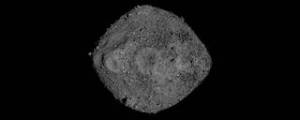
Lindsay Keller: Well, I mean, there’s that very extensive selection process to get us to going to Bennu, you know? That was trying to understand very primitive kind of astroidal material, astroidal material that we thought would be very organic-rich, where we’re looking for precursors to biotic life sort of things, the building blocks sort of things. Then you have to factor that into how you get to it and bring samples back. So it has to be in something that’s in an Earth-crossing orbit. It has to be a near-Earth object and that winnows down the possible candidates incredibly much. I think it was shown during the big press reveal event, the selection process. There was like this big pyramid, you know, where you have hundreds of thousands of asteroids, and you keep winnowing this down in terms of the characteristics that allow you to go there, bring it back, and have something that’s really interesting to look at in the laboratory.
Host: Yeah. Logistics, I think is what you’re saying is a decent consideration. Not only does the asteroid have to be interesting and have interesting aspects to it, but we wanted to get there and bring stuff back within a couple of years, and maybe not decades. So that was part of the reason.
Lindsay Keller: And these are all low-cost missions, right? So you’re flying solar-powered, you’re not flying a nuke, you know? So you have those considerations. It still took seven years, right? To fly this mission from launch till we got samples back.
Host: So Ann, maybe from a chemistry standpoint, or just maybe even high-level, when we think about Bennu, we think about this as a carbonaceous asteroid. What is particularly interesting about this particular asteroid?
Ann Nguyen: So we always want to know, where did we come from? How did life start on Earth? And so I think that was one of the main reasons, was to get a carbonaceous asteroid, and Bennu, you know, from the spectroscopy, fit that kind of criteria. We don’t really know where life came from, but organic matter and volatiles water came to Earth somehow. Cause Earth is so close to the Sun, these volatile materials would’ve just evaporated. They wouldn’t have been found in the rocks on Earth, for instance. So what was the vessel that brought it here? One of the hypotheses is it could have been an asteroid like Bennu that crashed into the Earth. So Bennu is a rubble pile and you see the cratering on our Moon. So the solar system is, you know, we think of it as static as planets, nicely moving around and its own little path, but it can be very violent as well. And sometimes those craters create life, and sometimes they extinguish it, like for the dinosaurs. Bennu is probably, you know, one of the keys to learning more about our history.
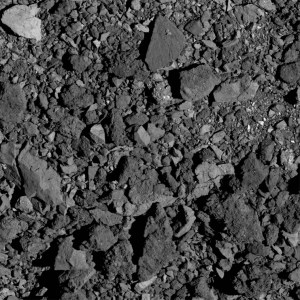
Lindsay Keller: I would add that one thing that’s so great about this sample is we have lots of meteorites on Earth. We send teams to Antarctica to collect meteorites off the ice almost every year. So we have tens of thousands of meteorite specimens in museums all over Earth. But those rocks came in from space. So there’s a selection bias in terms of what can survive atmospheric entry. And then it sits on Earth, and these things are full of organic molecules that bugs and bacteria love to eat. So pretty much every meteorite on Earth is contaminated in some way or another by Earth-based organisms. So going to the asteroid, grabbing a chunk, keeping it isolated from terrestrial atmosphere and interactions is in a curation glove box under dry nitrogen. Keeping it dry, keeping it organically clean is one of the first NASA samples ever where we can actually do this inventory of incredibly volatile organics, you know, the full suite of things. And we know it’s indigenous to the rock. It didn’t come from Earth, you know, it’s not contaminated.
Host: From a scientific perspective, maybe help me to understand the difference between the breadth of additional science that can be done with a pristine sample, like OSIRIS-REx, versus some of the meteorites that we find here on Earth, whether it be Antarctica. What’s the additional capacity for science that’s allowed by a pristine sample?
Ann Nguyen: Just in terms of the contamination part, you know, kind of like what Lindsay said is you may find something really interesting organically, but it’s sometimes hard to tell whether that’s indigenous to the sample itself, or whether it came from being here on Earth and just like the weathering aspect. And even as a meteorite comes through the atmosphere to reach the ground, you know, it’s going to get heated. It’s going to get altered to some extent. That’s the other thing is that our meteorite samples that we find are probably biased because they have to be hardy enough, strong enough, to resist, you know, that heating and going through the atmosphere. So fragile samples, possibly the Bennu samples may not have survived coming through, and certainly not the dust particles that we found to reach Earth.
Lindsay Keller: Yeah. It in addition, it’s not just the Earth entry sort of aspects of it. It has to survive being launched and broken off of an asteroid to become something that’s going to get launched toward Earth to begin with. And that usually ends up being something maybe more deep-seated. One of the really great things about the OSIRIS-REx samples is their surface samples. We explore the asteroid belt, not by sending a zillion missions to it. We use telescopes you know, the James Webb, we look at asteroid surfaces, we measure how the lights reflected, and that’s how we classify them and understand their mineralogy. So one of the first times where we actually have direct surface samples that were exposed to space is what we see in telescopes as opposed to something that’s deep-seated.
We’re trying to use the OSIRIS-REx samples now, not just to learn about Bennu, but to learn about a whole suite of asteroids in the asteroid belt that have similar-looking spectral properties that we measure telescopically. So OREx samples are going to be sort of this gift that keeps on giving because it’s going to really allow us—we call it “ground truth.” You know, we suspect based on these sort of spectral measurements, what we think the mineralogy and the composition of this asteroid is, alright, now we brought samples back. We can tear it apart down to the atomic scale and tell you exactly what it is and say “How good are the spectral interpretations as opposed to what we actually see when we analyze the sample?” And now you can use that kind of interpretation to look at other dark, organic, rich asteroids and say something about their mineralogy more precisely. Having hand samples of materials, you know, whether it be the Moon, I mean, or any of these bodies, basically revolutionizes what we know about them. You know, because there’s just so much more data, so much more information.
Ann Nguyen: Yeah. We kind of got a taste of that when the spacecraft arrived at Bennu and it was completely rocky. Huge boulders. Because from spectroscopy and telescopic visuals of Bennu, you’re like, “Oh, it’s going to be like a sandy beach. So, it’ll be easy to come down and get the sample,” but when they were presented with the giant boulders, it was a surprise.
[Laughs]
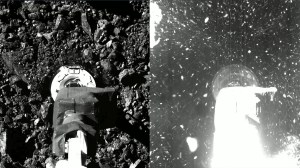
Lindsay Keller: Yeah. There’s early animation of the TAG event, these little animations of little spacecraft coming down and it’s like a desert sand dune, and it’s this nice smooth surface and it’s all happy. The TAGSAM comes down and you suck up the sample and away you go. And then, you know, that that the close approach when you first arrived at the asteroid and it’s like, “Oh my God.” There were concerns like, are we going to be able to sample anything? Is there fine stuff here? I mean, the entire surface is covered in boulders. You know, the original plan was to have this big ellipse. We just had to be able to autonomously land within this, I forget how big it was initially, and realized that once we got there and we spent our campaign around the asteroid to image it, there aren’t any spaces that are that big. And so the nav team had to go back in, work really hard on this autonomous navigation thing, this natural feature tracking system that came up to basically land us within a 10-meter crater instead of a 50-meter crater, you know, didn’t exist. And avoid these giant school-size rocks, you know, that would destroy the spacecraft kind of thing.
Ann Nguyen: And being on the science side and not the engineering side, and not understanding that, but seeing what they were able to do once they saw what they were faced with, I had the utmost respect for them.
Host: It goes back to Lindsay’s comment about the big team, right? You’re thinking about it. I’m talking to the planetary scientists here, and we’re going to dive deep into that. But the engineering alone that was needed to come up with solutions to narrow down that sample site is fascinating enough.
Lindsay Keller: Yeah. The other reason we’re here to talk to you about the samples. Otherwise, it had to be step one.
Host: Yeah. It was quite a journey, this one. And not just in terms of distance, but moments like that, right? Where you have to come up with solutions and you’re like, man, am I going to get my sample? I want to do my science. Zooming ahead to the samples return, I wonder where you guys were during that moment, and this is on September 24 of this year. 2023. Lindsay let’s go to you. Where were you during OSIRIS-REx capsule’s return to Earth? What was going on? What were your thoughts, feelings, emotions?
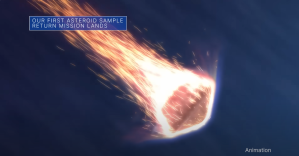
Lindsay Keller: I had the TV on at 8:00 a.m. and I was here. I was here in Houston. I got to be at the Utah test and training range for the Stardust entry, back in the day. So I felt like, okay, I had my experience. It’s time to let you know, a younger generation has that experience as well. So I watched it on TV, with my family, and yeah, sweating bullets. You know, it’s coming in and my family and my daughter and my wife were like, “There’s supposed to be a parachute.” Yeah. I know there’s supposed to be a parachute. There’s supposed to be a chute, there’s a chute. Yay. It’s like, all right. You know, we’re alive. We’re going to make it. It’s all great, you know? Cause we’ve lived through the Genesis crash back in 2004 or ‘05. So whenever that was, we had that fear during Stardust that it was built by the same team, whether this gravity sensing switch was upside down there too. It drove, chute came out. And it’s like, everybody’s like—
Host: Big sigh of relief, yeah.
Lindsay Keller: Just happy for all my friends, my friends, and my coworkers who were out there, you know, and just this perfect landing, this plunk, you know. Stardust came in and it was windy. It rolled and rolled and rolled. It made all these cookies out in the salt and flats.
Host: Yeah.
Lindsay Keller: This thing was plunk.
Host: It did, it looked perfectly upright. It looked like it hit a target. It was very cool.
Lindsay Keller: Extraordinary.
Host: Ann, your experience?
Ann Nguyen: I was also in Houston. Watching the bated breath. I was very nervous for the people in Utah. And I was actually happy I wasn’t there just because the nerves, I was like, I don’t know if I could take it. So watching from the safety of my house with my kids. And it was amazing to see, you know, I told you I wanted to be an astronaut. I remember as a kid in school watching rocket launches during class with my classmates. And it kind of took me back to that feeling of we’re making great strides here, you know? This is fantastic. My kids were excited too. They’re probably a little too young to really understand how exciting this is, but I just couldn’t help but think about the next generation of scientists. And maybe they would come to analyze these samples in the future too. That would be really cool.
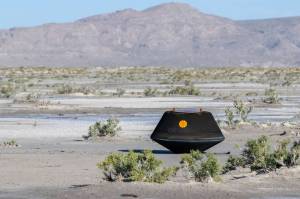
Host: Wow. Yeah. You were thinking way ahead. You were thinking what a big deal this was.
Ann Nguyen: Yeah. I couldn’t help but think back to my childhood and then where their path may lead them. And, you know, these sample are here for us to study now, but so much of it is going to be kept for future generations. That’s kind of really what excites me the most, is just seeing, or imagining what may come of the samples in the future. What are people going to learn?
Host: I got a taste of this when I was talking with some of your colleagues, at least over in building 31 with the curation facility on opening the Apollo samples. You know, why preserve something for 50 years? Well, we don’t know what we don’t know. We don’t know what fantastic instruments are going to come. That’s part of the wonderful science. Now, of course, you mentioned it landed in Utah, this sample canister, it was then transported to Houston. What was your experience for the first time that you actually walked into the lab and got to be close to the samples? Of course, you’re not in the curation team, you’re on the science team, but what was your first experience, Ann, with the sample?
Ann Nguyen: So Lindsay had earlier experiences with the sample, but we’re both working group or you’re a lead, I’m a deputy lead of a working group. And so a big part of our job is to communicate to our team. So I’m deputy lead of the elements in isotopes working group. And so I, along with the lead—you know, they’re distributed across the globe. So it’s kind of our job to communicate what the sample looks like and also well communicate to them, but also communicate their needs and what they want, what their interests are in the sample. And to try to come up with a plan to best allocate the samples and get what they need and want to do their analyses.
Host: They meaning the researchers around the world?
Ann Nguyen: Yes. So my first close encounter with the sample was during that phase of having the leads go into the clean room to see the sample. It was incredible.
Host: These are researchers who cannot wait to have their hands on the sample. you are guiding them close to this thing that they’re going to observe.
Ann Nguyen: Yes.
Host: What was their reaction?
Ann Nguyen: So I communicated. We were able to see through a feed, the sample, in the lab as the curators were working on them. That was exciting in itself, but actually being close to the sample was just another level of excitement. And it did look different up in close in person. It was kind of like, there are these small little speckles of like, salt, except they’re diamonds cause they sparkle. And that’s something that couldn’t really be captured through teams.
Host: And diamonds I think is a good analogy, especially with being a scientist. These are pretty much that precious to you. They’re as precious as diamonds. Lindsay, I wonder what your experience was like.
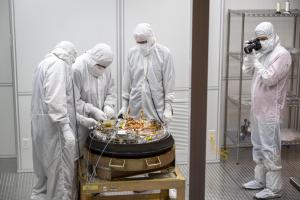
Lindsay Keller: I was really fortunate. I got to go in with the PI at the point where the science cannister was opened up and it exposed the TAGSAM for the first time. So the TAGSAM sitting on the avionics deck, you know, where the capture ring is. The last time I saw it, it was in space when the TAGSAM went, plunked it down with the capture ring and detached it. Then the SRC closed up. There was a pile of dust and granules along the edge of the flange that sealed the SRC and the TAGSAM itself covered in dust. The interior of the SRC covered in dust. You know, I’m there with the PI and we’re just, we’re giddy. Because it was just that we know we have sample and we have oodles of sample, and we have this material on the avionics deck that we collected very quickly. I mean, this was the day after my birthday. It was great.
[Laughs]
Host: Wow. What a present.
Lindsay Keller: The 28th? It was the 28th of September. I remember it well.
Host: Was your 28th birthday, right?
Lindsay Keller: Yeah. I was hoping they would open it on my birthday, but I had to wait a day. Anyway, and then that material, the curation staff scooped up like a hundred milligrams of this stuff. It was the fine powder in some of the sandy granules. And I’m part of a group that we call the Quick Look. It’s Quick Look Tiger team. It was something we had practiced many times previous, before the samples came back. But the idea is that we would do a bunch of sort of non-destructive analyses as much as possible to give the science team an idea. You know, did we get what we thought we were going to get? So we did some SEM work, some scanning electron microscopy work to look at the nature of the sample and some of the chemistry. We did infrared spectroscopy to understand what minerals were present and what volatiles were there. Some x-ray diffraction to figure out the minerals that were present in the sample. We did this in like three days. We had a three-day window of opportunity to do all this and then generate a report for the science team. So we briefed the science team, briefed the curation folks, just to give everybody an idea of what to expect. I mean, it was wonderful that some of the very first analyses of OREx material happened over here in building 31 on our instruments and things.
Host: Can you tell me more about that process? So you have these samples and you have these instruments, you have to carefully handle these samples, right? To put them into the different instruments. How does that work? Because there was so much work to get it just into this sealed nitrogen purge container. Right? So how do you—
Lindsay Keller: A hundred milligrams isn’t much material. You’ll think of like a quarter teaspoon sitting on a glass slide, you know? And using a combination of very fine tweezers and then needles to actually pick up individual particles and place them on the sort of sample supports that the instruments utilize. So we prepped all those samples that way, largely. I did a lot of the small particle handling. It’s what I do. I work on really tiny, small particles and we have a group that’s very good at that sort of work. Part of the reason I was on that team, plus I manage a lot of the labs and the facilities that we did all those analyses. And we have a nice dedicated group of scientists that helped out with all those measurements to help prepare that report for the PI and for the rest of the science team. So we largely confirmed what we—in some ways there were no surprises, let’s put it that way. You know, we knew from the sort of the orbital phase of the mission that we had some idea what minerals to expect and things. It was good to verify that, that we weren’t going to have any strange surprises. That we didn’t have to warn curation about anything weird going on in the sample, you know?
Host: From a scientific perspective, was it what we expected? Is that kind of exciting in a way that there are no surprises or maybe relieving is the better word?
Lindsay Keller: Well, at that level of detail, let’s just say there are no surprises. There’s going to be surprises. We already know there are surprises. I can’t really talk about them right now because there’s still embargoed in things because we haven’t published anything yet. But just at the grossest high level, you know, we expected to see hydrated minerals. We expected to see minerals like carbonates. We expected to see sort of carbon-rich material, you know, organic-rich material. Ann, what else am I missing?
Ann Nguyen: It’s kind of a confirmation of what was seen from the spacecraft as it was orbiting around Bennu and studying it.
Host: Which is good, right? Because we were talking about how this informs even observations from other instruments and observatories, but knowing that the instruments we have to observe and make predictions actually works out, that’s got to be huge just in and of itself for further observations.
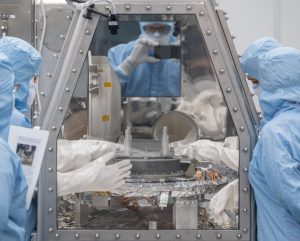
Lindsay Keller: Yeah. Make sure it’s not contaminated. Make sure there’s nothing that’s dehydrating, that’s sublimating that. Are there interesting Volatiles that we’re losing? Cause we weren’t aware that they were actually there in the sample, so it was very high pressure and very intense couple days in the laboratories.
Host: Were they long days?
Lindsay Keller: Oh yeah, Although, I mean, the mission’s been really, really good in terms of not overworking people. You know, if you let half those people in curation, half the scientists, they’d work 12, 16, 20-hour days. They would love to and you almost have to hold them back because it is intense. I mean, the curation folks are being sort of limited to four-hour shifts. And even that’s a lot. was in the clean room four or five times during this initial phase for the last month and a half. And just being in there for an hour, you know, you’re fully suited up in a bunny suit with masks and everything else. And yeah. It’s kind of exhausting, and that’s just spectating, you know, I’m watching. I’m watching people do that. That’s the hard stuff.
Ann Nguyen: That’s not manipulating the sample through the gloves.
Lindsay Keller: Right. Through these giant big rubber gloves and trying to do these very delicate things like picking individual particles off of part of the capture ring and putting it into a slide. You know, the dexterity and the skillset of the, the folks up in curation, hats off. I do a lot of that in my laboratory without big giant rubber gloves. And I appreciate how that’s done. It is remarkable.
Host: Yeah. In the last OREx episode, we got to talk to Mari Montoya about her zen-like state to be able to go into that and handle those samples.
Lindsay Keller: She and Christopher were, when I was up in the clean room, I was spectating cause, we’ll talk about it later, the contact pads that are in the TAGSAM. But during some of the practice sessions, you know, if somebody would drop at tweezers and you’d go [gasp]. Both Christopher and Mari were going like, “Just sit there, be calm, shut up.” We don’t need the audience participation here, making things that much worse. If somebody drops something, don’t say anything. Everyone’s just like totally zen, you know?
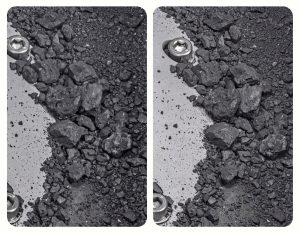
Host: So wait, so as they’re doing the curating, you are still actively participating in a monitoring. So what’s your role throughout those hours? When you monitor, are you documenting different things? What is your focus during those hours that you sit down?
Lindsay Keller: Well, I, I mean, in my case, I’m the lead. So the TAGSAM, the OREx mission basically collected two kinds of samples. The big sample that is sort of hoovered up and sucked off the surface of Bennu, right? That’s the big bulk sample. But on the bottom plate of the TAGSAM head, there’s what we call contact pads, and they’re made out of stainless steel Velcro loops. And the idea was that this would be a sampling of the material absolutely on the surface of Bennu. And it’s for the reason we talked about earlier, you want to be able to understand what was absolutely on the surface cause that’s what we see by telescopes. That’s what we saw by the spectrometers and the cameras that are on the orbiting spacecraft and things. So that’s our ground truth sort of thing. So my part of this curation experience was once they had gotten the TAGSAM off the capture ring and flipped it so we could see those contact pads, then it’s like, okay, how much material did we get? You know, are they jam packed with stuff? Are they empty? Did it work? Did it not work? We’re doing that sort of evaluation with the PI.
Host: Okay. Okay.
Lindsay Keller: It was largely an observe and comment. And the same thing what Ann was saying. You know, we were feeding that sort of information to a team that was feeding it then to the rest of the science team. Everybody’s watching that feed, the video feed out of the clean room. Then you have this running commentary over what’s happening and what people are doing.
Host: And it helps you to inform the scientific audience. It helps you to maybe make some decisions down the road.
Ann Nguyen: Yeah, absolutely. That’s part of our job in a way, is looking at the sample and kind of from a visual standpoint, seeing possibly how many different types of rocks are in there. And then telling our working group those characteristics and having them to help us in making a decision of which samples would be best for achieving our goals and answering the working hypotheses that we have for the mission.
Lindsay Keller: There’s been this fascinating progression. I love this. You know, we open up the SRC and we see dust and we’re so excited. And the analysis team is like, everyone’s excited, we got these granules and things, we have this dust, alright. And then we flip over the TAGSAM head and oh my God, there’s sample, there’s sample Then the curation team started scooping it out. And we ended up with like 70 grams and they’re in these little aluminum pizza trays, and we have all these images and everyone’s going, “Oh my God, we’ve got these giant boulders!” So to me it was hilarious watching the progression from getting excited about dust, to getting excited about sand, getting excited about gravel. And then finally, oh my God, we had big rocks, you know, it was just—
[Laughs]
Ann Nguyen: Yeah. And it was the images when they flipped it over and seeing the rocks, which are really centimeter size. But looking at those images was very reminiscent of images of Bennu, you know, the asteroid itself, but on a different scale. So it was really neat.
Lindsay Keller: People did that, people took some of the orbital images of like the boulder surface of Bennu and superimposed it next to like a blown-up image of the rock sitting in the TAGSAM. And you’re like going, “Okay, which one’s which?” It was very cool.
Host: Oh, okay. Yeah. Because part of doing good science is really understanding where, which part of Bennu each of these samples came from. And this is part of the process, right? The curation process. And this is where the curation team works very closely with you guys, works very closely with a scientist, is trying to communicate and best make sure that these samples are curated and organized and labeled as accurately as possible. This is where that dance is.
Lindsay Keller: You know, we have a wonderful relationship with our curation colleagues. You know, we live, work, play with them and socialize with them. It really is a wonderful symbiotic relationship and a real team effort going on over there right now.
Host: So, leading up, the quick analysis, right, where you had those three intense days of measurements, measurements, measurements, and trying to get that. At the end of that, you were one of the scientists, Lindsay, that was first exposed to some of those quick look things that we revealed to the world. And you got to see them and understand them and characterize them for us, the communicators, to be able to deliver externally. After you said 16 years of being with the Bennu and seeing this quick look, a first understanding of many to come with many researches and many more, this is step number one. What was that like after those three days?
Lindsay Keller: Well, it was intense, right? I mean, we had running bets over what we brought back, right? Everybody does this, right? You’re like, “What do you think we’re going to get,” you know? It’s an international team. We have Japanese colleagues that were on the Hayabusa2 mission. Ann was a participating scientist on that mission. She had good experience with that and we were having these running debates. It’s like, well, is this going to be different from ours or is it going to be the same as ours? You know, and we’d have these running commentary. It was just interesting. We kept looking for things, like, okay, do we see these, what Ann talked about, these very early sort of chunks of molten glass that we see in commonly other kinds of meteorites. These things called chondrules, our CAIs and things, and we’re not seeing them. And that’s a bit of a surprise, right. Realizing what an incredibly complex sort of fine-grained assemblage of things that we have and realizing that we’re just scratching the surface, we’re just getting the barest glimmer and glimpse of what’s in these samples.
Host: There it is. Just understanding that this is just the beginning of understanding. That has got to be so exciting.
Ann Nguyen: Yeah, part of our nature is when we first look at the sample, we try to relate it to other samples that we’ve seen before, like our meteorite samples, for instance. Like, is Bennu like this? Or like this classification? But I think we’re finding that it’s a unique type of sample, which is awesome, you know?
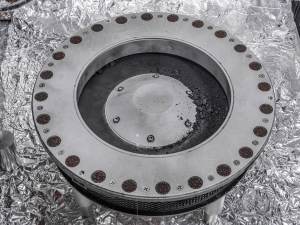
Host: Yeah. That’s exactly what you want.
Lindsay Keller: Yeah. I mean, interesting science regardless of how it turns out. But having something that’s different, unique is just a fascinating, nice situation to have.
Host: Very good. Yeah. Ann, we talked a little bit briefly about the different angles, right? So we got this quick look, right. You mentioned a couple of different extra ways, and you have to forgive me cause the science terms go in one ear, and I think you said something about isotopes, but even just a different perspective that maybe we haven’t even started on yet, that maybe excites you about a different scientific angle that we can take. What’s some of the work that you are doing to prepare the scientists for some of those observations?
Ann Nguyen: So as I said, our working group focuses on—well they did elemental composition as well, but elements and isotopes on the bulk level—but also down to the individual components that are within the sample so that we can understand it’s bulk properties and putting that in play with other asteroids, other meteorite samples that we have, but also individually like what components came together to create this asteroid and what kind of parent body processes happen to create certain faces in it. So isotopes tell us a lot about the origins of these components and the origins of the asteroid itself. So we made some ice topic measurements of part of the quick look samples. So that’s kind of giving us an initial idea of its bulk isotopic properties and elemental properties
Lindsay Keller: And how it might relate to other things we know about different classes of meteorites and different kinds of asteroids. One problem we have in the meteoritics community is that we know our meteorites very well, and we have the spectroscopy to tell us what kind of different kinds of asteroids are out in the asteroid belt. Alright. But we can’t say this meteorite came from that kind of asteroid. That’s still a very hard link to make and it’s another reason these sample return missions, like the ones we’ve us has done what the Japanese have done, have been so important because it finally allows us to say, “Aha! Here’s an asteroid. We got the samples of it. It corresponds to this large group of meteorites that we find here on Earth.” You know, and again, it helps tear apart this puzzle, which is the main asteroid belt. Then you have this vast mixture of different asteroids and you want to understand how they came to be and what can we learn about those asteroids based on the samples that we already have in-house. Having these hard data points where you have a one-to-one correspondence to this kind of spectroscopic asteroid, and these are the samples and this is what it looks like. These are its properties and you have a direct link, and then you can take that and run with it, like I was talking about earlier. It’s really important.
Host: I think what I’m hearing is, and let me know if I’m mischaracterizing, this is science based on the observations, based on what we’re able to collect can get us to a certain point, and then there comes a point where we need something else to help push our scientific understanding. And this is where something like an OSIRIS-REx sample return mission comes into play. Those pieces of the puzzle that are missing, that are gaps in our scientific knowledge, can be filled by investigating a sample like this. So that we can just continue, okay, we have an understanding now let’s push forward to that next thing, our next limit of understanding until we get that next mission.
Lindsay Keller: I mean, it’s the history here at NASA. We had all these wonderful models about how the Moon formed. The very first samples that came back had a piece of White Rock called Anorthosite, and it led to the discovery, the idea that there was a magma ocean, that there was a crust floating on top of it on the Moon and things, you know, it revolutionized lunar geology. Alright. The identification that we have some meteorites here on Earth that came from Mars helped revolutionize what we think about Mars, how Mars formed. Every one of these sample return missions are—I hate to throw the jargon out there but—these paradigm-shifting things, right. You know, it really does change our perspective on things.
Stardust, the comet mission, despite having micrograms of material really revolutionized our ideas about comets, how comets form, what’s in them, and where that material originated from. Stardust showed us that there was this large-scale of transport of dust in the early solar system from close to the Sun out past the orbit of Saturn and Jupiter. Bennu samples are going to do much the same for the meteorics community. We’ve already had a taste of that from the successful Japanese missions that have done similar sorts of things, and have revolutionized ideas that we had for 150 years on the nature of the most primitive kinds of meteorites that we have on Earth.
Ann Nguyen: Yeah. We have all these different flavors of meteorites, but we don’t know exactly which asteroid they came from. And we’re trying to understand, you know, why are there all these different flavors and what in their history created their characteristics that we’re measuring? But also being a rubble pile asteroid, how many different types of rock, how many flavors, came together to create the Bennu asteroid? And so I think having a large sample and being able to look at various stones within the sample will help inform the diversity of material that can be housed in one body.
Host: And it’s so exciting. You talked about, Lindsay, the progression of excitement as the sample sizes get bigger from dust to these small little rocks. Even with just the TAGSAM, you said we exceeded our mission goals from 60, I think we’re looking at 70 grams already. That’s really just the beginning. We still are working on getting the sample canister open. There could be more awesomeness inside of that.
Lindsay Keller: Yeah. You know, the design of the TAGSAM had this sort of mylar flap that was meant to allow material in but to be just strong enough to keep the material from falling out. And what happened is we were so successful that a large three-centimeter size rock kind of got wedged and kept the mylar flap open. And that’s why there was the excitement of closing up the TAGSAM when we were in orbit because sample was falling out. It was almost too successful that it was overstuffed with material. So it was like headquarters, Thomas Zurbuchen made the comment that, you know, my decision we’re closing it up, bringing it home, boom. The combination of when they took the material, talking about this progression of things, right? When looking at the TAGSAM, and we see these chunks of material on the mylar flap, and the curators are scraping that off and putting it into containers very carefully. They realize that that flap is pretty flexible. And they say, “If we wanted to, we could push that flap down and scoop out the stuff that’s underneath it.” It’s like, yes! Full speed ahead.
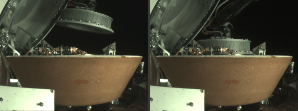
[Laughs]
Ann Nguyen: But calmly and carefully, zen-like.
Host: Yeah, right. Don’t scare the curators.
Lindsay Keller: Right. The curators are such wonderful, talented folks. And then they scooped out 70 grams and our level one requirement for mission success was like you said, 60 grams. We’ve now exceeded it. You know, we have more material than we expected. There’s still material in there. When materials are exposed in space, it can sometimes get what they call cold welding. It’s in vacuum, and there’s like a bond that forms between the metal. There are two reluctant fasteners that have proved difficult to open up with the current set of tools. But it’s largely a function of the strength of the steel used to make the tools. So right now, there’s an activity going on in curation to fabricate tools of a stronger steel that will not endanger, and contaminate the samples. In terms, we have a very limited list of materials that can be used in these curation facilities to cut down on any possibilities of contamination. So very shortly we’re going to have the remainder of the sample out. But in the meantime, because we have exceeded the sort of requirements of the mission, it is full speed ahead. The science team gets 25% of the sample up to right now, the nominal thing is 15 grams of the 60 will be allocated to the science team for the next six months. Five months, now.
Host: The NASA science team?
Lindsay Keller: The overall, the mission science team.
Host: Mission science team? Okay.
Lindsay Keller: The mission gets sort of exclusive rights to the sample for the first six months after return.
Host: Makes sense. That’s where the investment was.
Lindsay Keller: At the end of that six months’ time, the curation staff will prepare a catalog and will document everything that’s available. And at the end of that six month period, other scientists from throughout the world can submit requests to NASA for samples to study. And there’s a process in place for that kind of activity to happen. And then the rest of the world gets to have fun with them too.
Host: Are you part of the science team that’s working with those 15 grams over the next couple of months?
Lindsay Keller: Oh, yeah.
Ann Nguyen: Yeah, we will be.
Lindsay Keller: That’s the reward for 16 years investment.
[Laughs]
Host: So what are some of the key highlights that you’re looking forward to for the next six months? What are some of the investigations? What’s some of the science that you’re just itching to start?
Ann Nguyen: Yeah. So for me, since I’m interested in presolar grains, and I worked on Ryugu samples as well. So I’m really interested to see if they have kind of a different inventory of presolar materials, whether it be grains from other stars or in the form of organic matter and we find those by studying their isotopic compositions. We can’t really find a presolar grain just by the chemistry. We have to determine their isotopic compositions. And so we have specialized instrumentation that allows us to do that on a very fine scale. So I’m interested to see, and mainly the diversity of early solar system materials as well cause we’re finding like with, you know, Ryugu samples, meteorites, Stardust samples, there’s differences between those. And that does inform us about the transport of material early in our solar system. So I’m interested to see what Bennu captured.
Host: This is interesting about multiple missions too, not just understanding one perspective, but multiple. You talked about Ryugu and you talked about Hayabusa. This is what’s nice about having multiple missions is not only can you take a scientific perspective of saying like, “What’s this from?” It’s like, how does it compare to other things? Now Lindsay, you’re at the very small-scale is your expertise.
Lindsay Keller: Yeah. Electron microscopy. We can basically image and analyze these materials down to atomic scales. I’m interested in the minerals, the makeup of the samples. And you can use the nature of the minerals that are there, the assemblage of minerals to tell you things like, how hot was it when these minerals formed? What was the pressure? What was the composition? Was it pure water? Was it salty water? You know, a lot of those things inform you about how the asteroid formed and evolved through time. Then Ann and I collaborate on the same samples. We do something we call coordinated analysis where I do all my kinds of analysis, and then it goes into her instrument. She makes isotopic measurements destroying the sample.
Ann Nguyen: Yes.
Lindsay Keller: Because it’s the nature of the analysis.
Host: Well, you have to.
Ann Nguyen: It goes back and forth, you know?
Lindsay Keller: Right. We do it back and forth. But it’s a technique where we sort of maximize the science out of a tiny amount of sample. You spent all this effort trying to get these little tiny samples into these instruments and they’re precious. You know, there’s a finite supply of Bennu material on Earth. It looks like it’s a lot. So we do these sort of coordinated measurements because I can tell you, “Oh, it got hot. It got wet. These minerals formed around this temperature.” The kinds of measurements Ann does, you can say, “Yeah. But that happened probably 3 million years after the formation of the solar system, the water probably came from ice from the outer solar system.” And you tie this nice story together when you sort of combine these really key measurements into one package.
Ann Nguyen: Yeah. That’s kind of goes back to what I was saying about having all these 200 plus scientists on the team. You know, Lindsay and I coordinating our techniques already tells us more about a grain that could be just a micron or a couple nanometers in size. And think about what we can learn if we had all these other techniques around the world that can be applied to it. But it’s a matter of scale too. So some techniques require a lot of material, some techniques look at it on, you know, centimeter or millimeter size scale. And then we’re looking at the fine scale. So putting those pieces of information together will give us a more well-rounded story.
Lindsay Keller: And we’ve just sort of finished the early stages of an exercise, trying to pick out the rocks that the science team wants to use. You know, these eight rocks I was saying earlier. And we’re looking at sort of surface characteristics. We’re looking at this scale, at the centimeter scale. And then those will get torn apart, down to finer and finer. There’ll be this progression of analyses from bulk measurements of say just the density and the porosity of a one centimeter square chunk. And then we will cut that and polish it and analyze it in the electron microscopes and other instruments. It’ll eventually make it into my microscope. It’ll make into her mass spectrometer. And we will make those measurements down to that tiny scale and assess whether this is a uniform body, whether it’s a heterogeneous body, are there chunks from other asteroids? And we know it’s a rubble pile. We suspect there’s chunks from different epochs of the proto planetary disc. We’ll find out, you know? It’s going to keep us busy. We’re funded for the next two years. I know what I’m going to be doing.
Ann Nguyen: You know, when Lindsay said, the quick look results weren’t necessarily surprising, but I think once we delve deeper into the samples and more of it, we’re going to be finding a lot of surprises.
Host: That’s absolutely fascinating. I feel like I could talk to you guys forever. But just to bring it on home. Right. There’s so many interesting things already that we’re looking at for Bennu and so much to come. Just thinking about the work that you have over the next six months as part of the science team, knowing that scientists are engaged from around the world and want to further explore this and understanding of things that both of you guys are looking at. Ann, maybe we’ll start with you, is just thinking about what are you looking forward to most for the future here? Now that we have this sample, now that we’re working on it, we’re doing the science. What excites you the most?
Ann Nguyen: It’s honestly, maybe not exactly what I’m going to discover, but what’s going to be discovered down the road. I mean, we all have our own interests and what we want to study in the sample, but I almost think part of the fun is when like the sample presents its discovery to you, it’s secrets to you in a way. You know, I had that experience looking at the Ryugu samples where I was poking around with my instrument, but I found something I didn’t expect. And to me, that’s really, really fun. That’s what makes this job fun. And I think Bennnu is going to do the same. And I think down the road, you know, when there are new instruments and new scientists, that they maybe will find something that refutes what I find in my samples. And I think that’s going to be—I’m excited for
Host: Yeah. That’s an exciting thing, right? It’s just progressing the scientific understanding. Absolutely fascinating. Lindsay, what are you excited about?
Lindsay Keller: Well, I mean, it is the same thing, like the instrument I use. I mean, I do a lot of work on lunar samples still, well, not anymore right now, cause I’m up to my neck in OREx samples. But the instrument I used didn’t exist during the Apollo program. Right. And thank God the curators did a nice job and kept samples pristine. So that when I was here at JSC as a postdoc many moons ago, I had pristine samples to work on. I did some very interesting science that I’m very excited about. That whole experience led to my involvement in this mission. The contact pad, things that I’m working on are fundamental to the kinds of my scientific interests. You know, I cannot wait. We cannot wait to tear into those samples. You know, there’s a process called space weathering where materials sitting on the surface are exposed to radiation and impacts and it changes the surface, which is why we’re interested in getting those sort of surface samples as opposed to something from 40 centimeters deep in Bennu.
So that was why there’s this two-tiered nature of the sampling of OREx and tearing apart that material. And it’s fine grained. You have to go in down to it in the atomic scale. And we’ve tried to simulate this in the laboratory. I want to see if we did it right or not, you know, and now we have the real samples to say whether or notwe’re trying to learn and trying to anticipate what we were going to get back. So yeah, that’s my bread and butter for the next six months.
Host: Well, you’re certainly going to be busy. So I’m truly grateful for both of you to be taking some time to sit down and chat with me. I know you have a lot ahead of you, but to share all the exciting science that we just are skimming the surface of, and then just knowing there’s so much more to come. It’s been an absolute pleasure to talk to both of you. So Lindsay and Ann, thank you so much for coming on. Houston We Have a Podcast.
Ann Nguyen: Thank you very much.
Lindsay Keller: It’s been great.
[Music]
Host: Thanks for sticking around, I hope you learned something today. Quick update on this episode. We recorded this November 7, 2023. Now recording this outro January 17, 2024, happy to report that the curation team successfully removed two fasteners from the sampler head using a specially fabricated tool. Check out the OSIRIS-REx blog for the latest on the curation steps and science of the historic mission. This is not the first time we’ve discussed OSIRIS-REx. You can listen to Episode 27, “The Search For Life” which we recorded before OREx reached Bennu, then listen to Episode 285, which is “Return of OREx: Part I,” and we talk more about the spacecraft’s arrival at Bennu, and the initial prep. And Episode 306 for a deep dive into the curation facility and prep for the sample’s arrival.
Check nasa.gov for the latest on what’s happening in the agency. You can find our full collection of episodes at nasa.gov/podcasts, and also check out some of the other shows we have across the agency. On social media, we’re on the Johnson Space Center pages of Facebook, X, and Instagram. Use #AskNASA on your favorite platform to submit an idea or question for the show – just make sure to mention it’s for Houston We Have a Podcast.
This episode was recorded November 7, 2023. Thanks to Will Flato, Dane Turner, Abby Graf, Jaden Jennings, Dominique Crespo, Shaneequa Vereen, Rachel Barry, and Erin Morton. And of course, thanks again to Lindsay Keller and Ann Nguyen for taking the time to come on the show. Give us a rating and feedback on whatever platform you’re listening to us on and tell us what you think of our podcast. We’ll be back next week.


























